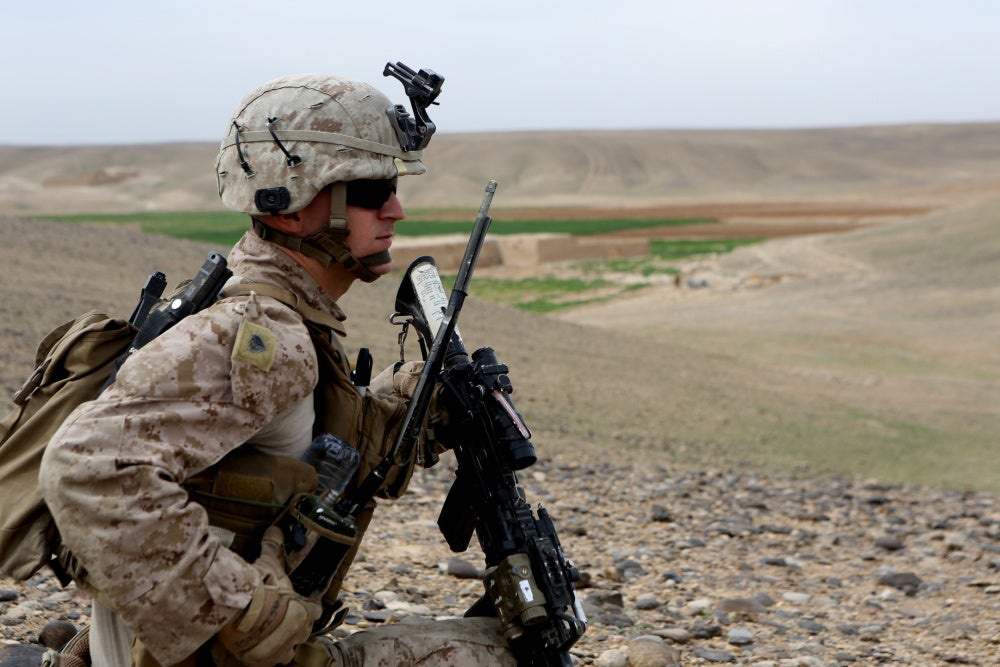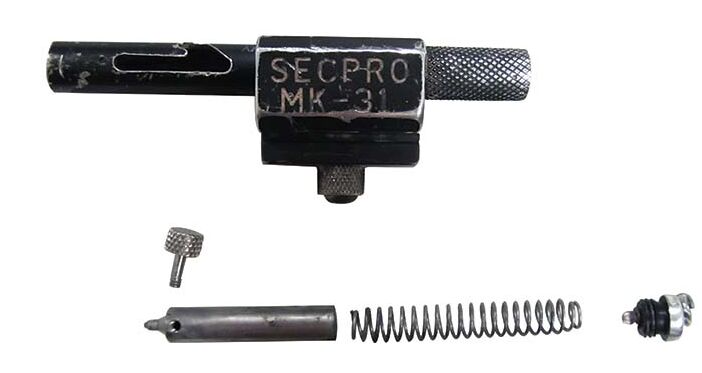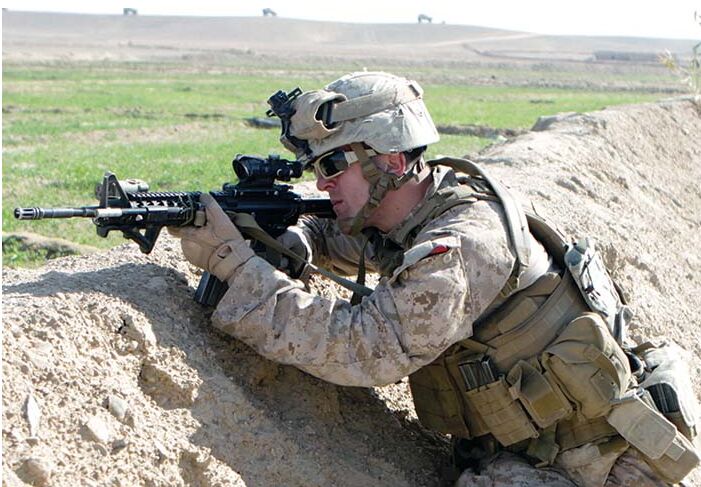Unfortunately, an inevitable result of any large-scale military counter-insurgency operation are unintended, innocent civilian casualties otherwise known as collateral damage. The questions stated to military planners are not “If” but instead “When”. How any modern Infantry forces works through this sort of preparation can sometimes determine the difference between winning and losing against a determined insurgency of any time.
In order to mitigate civilian casualties, one method that was used was pen flare employment. The nomenclature for this particular device was the “Mk 79 Mod 0 (Mark 79 Modification 0) Illumination Signal Kit”, and the actual tube being the “Mk 31 Mod 0 Signal Projector”. The cartridges were “Mk 80 Mod 0”.
Unlike a standard pop up signal pyrotechnic that is almost a foot long, and takes up space, a pen flare can be carried in a small pocket or mounted to the Picatinny rail of almost any small arm in the current inventory as long as it has a rail. Although initially designed for survival rescue with pilots in the Vietnam War, it later entered service as an EoF tool in Operation Iraqi Freedom. Mounting it to a Picatinny rail was the result of an odd call to LaRue Tactical from a servicemember in Iraq.
This excerpt is from a 2009 article called Show of Force, published in Tactical Life–
Another drawback of using the hand-held pen flare is that if the approaching vehicle or personnel fail to heed the warning flare, the soldier needs to have his weapon up and ready to engage the threat. Because of the safety and operational drawbacks of using the Mk 31 projector, a soldier in Iraq was inspired to come up with a solution. The soldier placed a satellite phone call to the shop of LaRue Tactical located in Leander, TX. After the soldier explained how the Mk 31 pen flare was being used and what its limitations were, he asked the LaRue staff if they could fabricate some type of weapon mount to hold it. The soldier wanted to be able to fire off the pen flare while his weapon was shouldered and ready. In an inopportune twist of luck, the satellite phone call was dropped before the LaRue staff was able to get the soldier’s name and contact information.
Anyone who has ever purchased equipment from LaRue Tactical before can tell you that they are eager and willing to help the customer in the field get the gear they need. This is especially true of the men and women serving the cause of freedom in the military. LaRue soon acquired the Mk 31 specifications and a test example to examine. They determined that the diameter of the Mk 31 tube body was 12.7 millimeters (0.5 inch). LaRue fabricated an appropriate mount to hold the Mk 31 which they designated the LT-663 Pen Flare Mount. The LT-663 includes LaRue’s standard quick attach/detach LT-171 Locking Lever rail interface mount which works with any military specification Picatinny rail system.
When it comes to injuries we have this news article about two Australian soldiers that accidentally discharged their pen flares while on patrol in Oruzgan province in 2008. Ironically the one soldier injured himself by having an ND with it, then another soldier had an ND as well when he went to go help him. We also have accounts of civilian injuries with pen flares, due to the flare being shot or finding its way directly into oncoming vehicles. This is an example from the book, Al Qaeda, the Taliban, and Conflict in Afghanistan–
In so far as my own experience with the pen flare, I’ll talk about The civilian casualties kept mounting and our higher-ups came under increasing pressure to do something about it. So the command worked with issuing out pen flares to the battalion. The idea was to establish Rules of Engagement (ROE) that would make it more conducive for Afghan civilians to have a chance to stop if they weren’t Taliban by having a comprehensive Escalation of Force plan. ROE was as such when a suspicious vehicle or person is approaching a foot or vehicle patrol-
- Wave a brightly colored flag if in the turret of a tactical vehicle, wave a small piece of brightly colored cloth if on a foot patrol.
- If the vehicle hasn’t decreased speed, take out a prepped and loaded pen flare and fire it in the general direction of the vehicle. Don’t shoot it directly at the vehicle.
- The vehicle is still approaching at speed, fire a full-size pyrotechnic flare if mounted in a vehicle or try to fire another pen flare if dismounted.
- If the vehicle still hasn’t stopped and is accelerating, engage it with whatever the most efficient weapon system is available until it no longer becomes a threat.
This is a video of Major General Toolan trying a pen flare out for himself. The audio is atrocious from the generator used to power the the perimeter guard post.
Initially, every Marine who went outside the wire on dismounted and mounted patrols was issued an individual pen flare with a lanyard, and a plastic bandoleer of 7 cartridges. Pen flares were initially designed for downed pilots in the Vietnam War era as an Escape and Evade tool. It allowed a pilot to signify his position to a rescue aircraft or squad on the ground. They had to be small enough to fit in the vest that a pilot would be ejected out of his plane with. They were around the size of a pen and thus the name of “Pen Flare” stuck.
To operate the ones we had, you had to “cock” the pen flare by bringing back a bolt like handle into a rear notch. Then one would screw the small cartridge onto the front of the flare. To operate it, you had to point it in a safe direction, release the bolt handle similar to an open bolt submachine gun, and it would go off with some recoil. The shell of the cartridge would be left screwed on to the pen flare and this had to be unscrewed if another round were to be fired. These flares would go arch around 50-70 meters into the air, depending on what angle they were at. Although I never used one at night, they most likely wouldn’t have provided much ambient light at all.

This was actually my former section leader, Sergeant Chris Leonard while on patrol. Note the pen flare attached to the left side of his M4.
So initially everyone in the battalion had these pen flares and the SOP was that you had to keep the flare and the cartridges on you at all times when outside the wire, ready to deploy them should an escalation of force situation arise. Then things got interesting and the battalion head shed mandated that they be attached to our personal weapons via a Picatinny rail adaptor that was issued out. We didn’t get to keep any of this equipment at the end of the deployment as it had to be signed for and turned back in.
The idea behind mounting it on our rifles was so that they were more accessible should we actually need them on a dismounted patrol. Although a sound concept, one large issue with this mounting set up was that the pen flare itself wasn’t designed to be attached to a rifle that is getting banged up going inside and outside vehicles and compounds. It was designed be softly carried in a case on a pilots vest, ready to be used only in an emergency. Thus, the metal that the tube was made out of was softer than most metal attachments that go on a rifle. This led to some pen flares getting dented from constant use on patrol and back at Leatherneck.
We did end up using the pen flares, although only sparingly. I myself shot one in the direction of an oncoming van that abruptly stopped and turned around. It might have indeed saved some civilian lives after all.
I know 1/9 wasn’t the only infantry unit in Afghanistan that used pen flares as ROE items but also mounted to our rifles. I’ve seen images of some Army units with a mount that actually locks on to the 6-inch barrel in front of the front sight post.
The purpose behind this article was to add this bizarre and odd accessory to the wealth of historical knowledge concerning small arms employment in Operation Enduring Freedom.
 Your Privacy Choices
Your Privacy Choices




